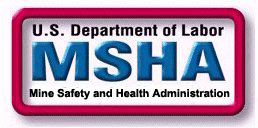
Mine Safety and Health Administration
Protecting Miners' Safety and Health Since 1978

 |
U.S. Department of Labor Mine Safety and Health Administration Protecting Miners' Safety and Health Since 1978 |  |
| www.msha.gov |
| Find It! in DOL | Compliance Assistance | |

On October 18, 1999, a 48-year-old shaft maintenance repairman was fatally injured at a metal mine while performing a routine shaft inspection. The repairman and a coworker had climbed onto the work deck on top of the production skip while it was positioned at the shaft collar. The repairman radioed the hoist operator to raise them. As the skip moved upward the repairman's safety lanyard caught on a guide rail bolt. His rope lanyard had not been tied off, instead it was left with both ends attached to his safety belt D-ring which formed a loop hanging behind him. The accident occurred because the repairman did not secure his safety lanyard prior to radioing the hoist operator to raise the skip. One simple remedy is to have the hoist operator ask if everybody is tied off before moving the hoist. This practice is similar to an automobile driver asking if all the passengers are buckled up before moving the vehicle. Even the best maintenance personnel may be distracted by their work responsibilities, personal problems, or just simply forget to secure their safety lanyards. This simple check between the hoist operator and the lead maintenance repairman would remind all the maintenance personnel to secure their safety lanyards. A designated attachment point should be provided on the work deck for the safety lanyard. The location of the attachment point should be carefully selected to prevent the lanyard from getting snagged or entangled when the work deck is moving. A lanyard electrical interlock should be provided on work decks equipped with pendent electrical control stations. The electrical interlock will prevent movement of the work deck during inspection and maintenance if the lanyard is not attached. MSHA encourages all mine operators to adopt the practice of requiring the hoist operator to confirm that the shaft maintenance personnel have secured their safety lanyards to a designated attachment point before moving the conveyance. In addition MSHA highly recommends the use of shock absorbing safety lanyards which provide a gradual stop if a person should fall. The shorter length of the shock absorbing lanyard also reduces the chance of them becoming snagged or caught in moving equipment. In the event that the safety lanyard should be caught or entangled, the shock absorbing feature would eliminate the sudden, jerking, impact associated with a rope lanyard. This would allow more time to respond to an emergency situation before severe crushing injuries occur.
|
|
|
www.msha.gov | www.dol.gov |
|
| ||
|---|---|---|
|
| ||
|
Mine Safety and Health Administration (MSHA) 1100 Wilson Boulevard, 21st Floor Arlington, VA 22209-3939 |
Phone:
(202) 693-9400 Fax-on-demand: (202) 693-9401 Technical (web) questions: Webmaster On-line Filing Help: MSHAhelpdesk@dol.gov or call (877) 778-6055 Contact Us | |